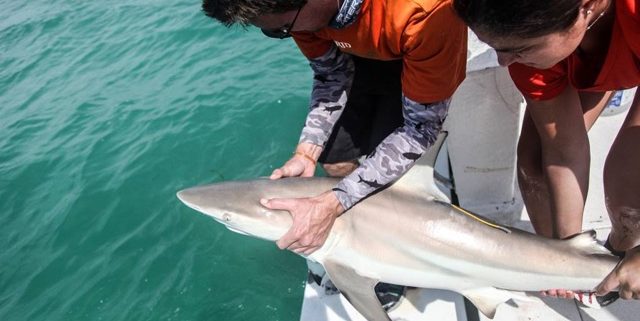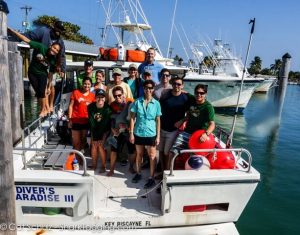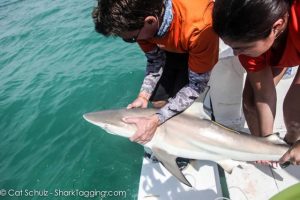Shark tagging with the Virginia Aquarium
by Hannah Armstrong, RJD intern
On Friday, February 27th the RJ Dunlap team set out for what we all anticipated to be a great day of shark research. I was eager to head out into Biscayne Bay, as this was my first trip of the New Year. I had the pleasure of being on a boat with our fearless leader, Christian, as well as Nick, Laurel, Cat and visiting RJD alum, Megan, and an energetic group from the Virginia Aquarium.
During the short, 20-minute boat ride into the bay, we did our usual prep work, including preparing bait, setting up the drum lines, and briefing the citizen scientists on board. Upon arriving at the Safety Valve, a shallow site just off Key Biscayne, we began deploying the drum lines with the help of the guests from the Virginia Aquarium. Everyone was eager to lend a hand and get the day started.
During the hour soak time, Christian gave a detailed explanation of the work up procedure in the event that we had a shark on the line, and spoke about the importance of our research. Little did we know how exciting our day was about to get…
Despite the first six lines coming up empty, we were all startled when our captain Nick shouted, “Look! There’s a shark on seven!” Low and behold, there was a blacktip shark thrashing about, breaching out of the water by our drum line! We quickly motored over, but the hook came loose and the shark darted off into the abyss.
From then on, there was little time for rest or even lunch. The next two hooks also had blacktip sharks on them that we were able to successfully tag and release. Each time a shark was on board, the guests quickly completed their jobs, taking measurements and other samples to be used in ongoing lab research projects.
On the second set of drum lines, we managed to tag and release another three blacktip sharks, measuring in at 162, 167, and 152 centimeters. On the third and final set of drum lines that we set, our team was able to successfully tag and release four more blacktip sharks. Overall, it was a thrilling day of shark research for our team as well as the cooperative citizen scientists from the Virginia Aquarium!






Indeed this occured in Tiputa Pass in Rangiroa and was fiemld by Yann Hubert. They use the strong current in the pass to oxygenize themself when immobilezed during the mating.By the way, nice picture of blacktips also! (I have one too from Rangiroa).